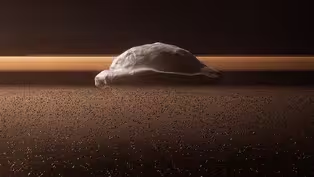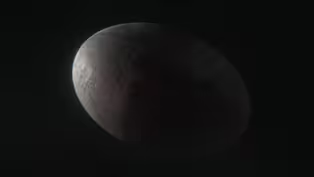
How a Walnut-Shaped Moon Help Shape Saturn’s Rings
Clip: Season 51 Episode 10 | 2m 35sVideo has Closed Captions
For millions of years, a tiny moon has made a significant impact on the structure of Saturn’s rings.
Shaped by gravitational forces over millions of years, Saturn's rings are incredibly complex. A tiny moon named Pan, just 17 miles wide, has notably influenced their structure by creating the Encke Gap.
Problems playing video? | Closed Captioning Feedback
Problems playing video? | Closed Captioning Feedback
National Corporate funding for NOVA is provided by Carlisle Companies and Viking Cruises. Major funding for NOVA is provided by the NOVA Science Trust, the Corporation for Public Broadcasting, and PBS viewers.

How a Walnut-Shaped Moon Help Shape Saturn’s Rings
Clip: Season 51 Episode 10 | 2m 35sVideo has Closed Captions
Shaped by gravitational forces over millions of years, Saturn's rings are incredibly complex. A tiny moon named Pan, just 17 miles wide, has notably influenced their structure by creating the Encke Gap.
Problems playing video? | Closed Captioning Feedback
How to Watch NOVA
NOVA is available to stream on pbs.org and the free PBS App, available on iPhone, Apple TV, Android TV, Android smartphones, Amazon Fire TV, Amazon Fire Tablet, Roku, Samsung Smart TV, and Vizio.
Buy Now

NOVA Labs
NOVA Labs is a free digital platform that engages teens and lifelong learners in games and interactives that foster authentic scientific exploration. Participants take part in real-world investigations by visualizing, analyzing, and playing with the same data that scientists use.Providing Support for PBS.org
Learn Moreabout PBS online sponsorship- [Narrator] Saturn's rings are amazingly complex.
- [Narrator] And the more we zoom into them, the more complex they seem to be.
- It is one of the wonders of the solar system.
- [Narrator] Scientists think the rings may have first formed when a moon strayed too close to Saturn, (rocks rumbling) and was pulled apart by its gravity, creating a jumble of trillions of individual fragments of rock and ice.
(mysterious music) So what turns such chaos into the ordered beauty we see today?
NASA's Cassini spacecraft gave us the best view of the rings we've ever had.
- The photographs from Cassini gave us Saturn's rings at all angles.
We saw them reflecting light from the sun.
We saw Cassini look through them toward the sun, just the spectacular beauty of them just mind blowing (static buzzing) - [Narrator] And lurking among the loops of rock and ice.
Cassini imaged one of the most startling moons in the entire Saturn system.
- So Pan is this weird tiny object.
It is only 17 miles across and it looks for me like a walnut, - And it looks like it has a dusting of material around it that could easily break off if you were to touch it.
- [Narrator] Despite its small size, Pan has a big impact on the structure of the rings.
- Pan is a great example of how gravitational interactions can shape Saturn's rings and create the gaps that we see.
- [Narrator] Pan orbits inside a wide track within Saturn's rings called the Encke Gap.
- We think Pan created the Encke Gap by cleaning the orbit and by accumulating all this ring material, dust and ice, around it.
- This ring material has settled specifically on Pan's equator again and again and again, and that meant there is this large ridge around Pan itself.
- It looks like an empanada because so much water, ice from the rings have built up around its equator.
- [Narrator] For millions of years, Pan has been nibbling away, clearing particles out of its orbit, and creating this pathway.
Only that can't be the full story.
Solar System: Strange Worlds Preview
Video has Closed Captions
Preview: S51 Ep10 | 30s | What are the weirdest worlds in our solar system, and how did they come to be? (30s)
Why is Haumea Shaped Like an Egg?
Video has Closed Captions
Clip: S51 Ep10 | 2m 30s | Most objects with a radius over 200 miles are spherical, but Haumea is an exception. (2m 30s)
Providing Support for PBS.org
Learn Moreabout PBS online sponsorship
- Science and Nature

Capturing the splendor of the natural world, from the African plains to the Antarctic ice.

- Science and Nature

Learn how centuries of knowledge helped our ancestors understand the mysteries of space.












Support for PBS provided by:
National Corporate funding for NOVA is provided by Carlisle Companies and Viking Cruises. Major funding for NOVA is provided by the NOVA Science Trust, the Corporation for Public Broadcasting, and PBS viewers.



